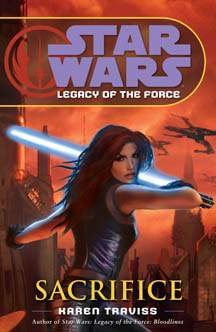Before this re-read, I had thought of “The New Jedi Order” as the dark and grim “Star Wars” saga, but “Legacy of the Force” surpasses it with its fifth entry, “Sacrifice” (2007). For some reason, Mara’s death doesn’t get as much hype as Chewbacca’s or Anakin Solo’s, but it should. Karen Traviss’ writing of Jacen’s murder of his aunt is exquisitely handled, with Ben and Luke sensing her death in one poetic paragraph each (page 376 of the paperback), and we know the aftermath in the final four books will threaten to tear apart the bond between the Skywalker and Solo families.
Traviss, in a style that is somewhat controversial among fans, spends a lot more time in the headspaces of characters and dealing with military and political minutiae than other authors do. To me, that makes her combat scenes all the more gripping when they do occur, and the fight between Jacen and Mara in the caves of Kavan – and to a lesser extent, the battle between Luke and Lumiya on the cliffs of Terephon – is a page-turner.
I’ll register a complaint now, seeing as how “Sacrifice” marks the last time we’ll see Mara and Lumiya. I would’ve liked more scenes of Mara talking to Ben about her past as the Emperor’s Hand and how she came to learn that she had been serving evil. Throughout the saga, I think Mara transitions from evil to good a bit too easily; she should’ve paid more of an emotional price since a legal price was never broached (as it often isn’t for high-level soldiers and officials in wartime; see also Kyp Durron).
I also would’ve liked to see the Mara-Lumiya clashes, which Mara alludes to in “Exile,” from when they both worked for the Emperor and Darth Vader. Why would two people on the same side clash? Did they have different values that created a riff, even when both served the Sith cause? Since “Star Wars” stories rarely include flashbacks, and since the “Star Wars Tales” comics were over by this time, perhaps the best outlet would’ve been a Star Wars Insider short story.
Before the epic and emotional finish, “Sacrifice” starts slowly, with Traviss’ trademark detail-oriented storytelling. Galactic Alliance Guard leader Jacen is frustrated with the slow response time to his equipment requests, so he consults a lawyer droid and finds a loophole to change the law. Then he realizes changing that law allows him to change another law, which allows him to arrest and depose Chief of State Omas, allowing him and Admiral Niathal to assume the reins.
It’s an effective commentary on both FISA courts and executive orders, although “Star Wars” authors have always shown more regard for the GFFA citizenry’s engagement with government than that of modern U.S. citizens, who often give a pass to outright corruption. But Jacen is a slick politician by the standards of any time and place, and by showing a handful of protesting taxpayers that the chief of state’s office is blocked off, awaiting an elected chief, he assuages their concerns.

Traviss also shows that this bloodless coup is not emotionally easy for the perpetrators. One of the guards who accompanies Jacen to arrest Omas notes that it was the hardest thing he ever had to do; this scene may not match the attempted arrest of Darth Sidious in “Revenge of the Sith” for fireworks, but it has emotional truth. Ben’s assassination of corrupt Corellian Prime Minister Gejjen is likewise artfully done, as Traviss notes Ben’s numbness starting at the point when he pulls the trigger. She doesn’t even describe the bullet strike; we simply know from the chaotic response that Gejjen is dead. Most readers haven’t assassinated someone, but we can appreciate the way it feels like a traumatic event to Ben.
The stuff with the Solos and Skywalkers is so dark that the Boba Fett storyline – revisited for the first time since the last Traviss entry, “Bloodlines” – is the happy part of the book by comparison. While there had been a bit too much time spent in Boba’s head (even by Traviss’ standards) as he reflects about his lonely lifestyle and the fact that even his granddaughter doesn’t like him, the Mandalorians’ relation to the wider “LOTF” saga gets ratcheted up when a lode of beskar metal is found on Mandalore. The Galactic Alliance engaged in this war over fear of how much armament Corellia had, so naturally, Mandalore is in the saber-rattling mix now that they possess cutting-edge beskar starfighters.
On the subject of backstories that were never told, I would’ve liked to know more about how Fenn Shysa handed off the title of Mandalore to Boba Fett. I suspect this is something Traviss would’ve gotten to at some point if not for her falling-out with LucasBooks after “The Clone Wars” reinvented the planet and culture of Mandalore.
In terms of forward-looking story points, there is potentially a good one coming up as Fett and Mirta learn that the supposedly long-dead Sintas (Fett’s wife and Mirta’s grandmother) is possibly still alive, frozen in carbonite. Another blast from the past comes when Fett meets Venku (later revealed in the “Republic Commando” series to be the son of Darman and Etain); this is a nice bit of continuity among the Mandalorian culture, which is close-knit due to its small population, despite being nomadic.
One more small criticism of “Sacrifice” and the “LOTF” series: Communication across the galaxy is super-easy in this series. Mara uses a transponder that allows her to know where Ben is anywhere in the galaxy; I’ll allow this for two reasons: because a homing beacon was introduced in “A New Hope” and because Mara notes that it is the last piece of tech left over from her old Imperial gear. Presumably it’s not a gadget that can be purchased at the “Star Wars” equivalent of RadioShack.
But the idea that people can have real-time two-way conversations across the galaxy – as, for example, a Hapes space-based Luke has with a Coruscant-based Corran – is jarring. The “Star Wars” novels have always been inconsistent about how intragalactic communication works. There are numerous stories where messages are sent via the HoloNet (basically, emails) as it’s implied that real-time communications (cellphone calls) can’t happen due to basic rules of science, and even science-fiction. Just as a ship takes time to travel through hyperspace, so should a message. Yet there are other stories –”LOTF” is one, and I recall “The New Rebellion” being another – where communication can happen crisply and instantly through hyperspace. (Presumably, this is one of those inconsistencies that would be left to Legends while the new Disney canon delivers a firm set of rules, although I wouldn’t bet on it.)
Despite these quibbles, “Sacrifice” is daring, muscular storytelling that cuts to the heart of the Solo and Skywalker families. Jacen has long since been a frustratingly irredeemable bad guy – although he doesn’t name himself Darth Caedus (meaning “a battle of darkness”) until the final line of this book – but his behavior’s impact on his loved ones is arguably even more stirring than an extragalactic invasion.

